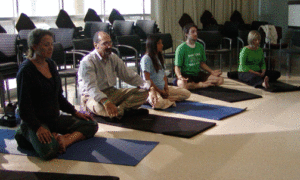By John M. de Castro, Ph.D.
“The idea behind mindfulness meditation is to observe the present moment by paying attention to the breath and body, as well as thoughts and emotions. People with challenges related to addiction tend to act out on addictive behaviors to avoid uncomfortable feelings and to bring pleasure. . . . Mindfulness practices help the client to learn to face the present movement with all of its pleasant and unpleasant sensations, feelings and thoughts.” – Eric Millman
College students make up one of the largest groups of drug abusers nationwide. Alcohol is the most abused substance, but there are many others. These include: marijuana, prescription medications (including stimulants, central nervous system depressants, and narcotics), over-the-counter drugs, cocaine, heroin, and ecstasy. Of these marijuana is the most commonly abused substance by college students. In fact, 47% of college students have tried it at least once, with 30% admiting to using it in the past year. In addition, one in five college students admits to using amphetamine and 13% of college students admit to using ecstasy at least once in their lives.
These are sobering statistics and underscore the need to find effective methods to prevent and treat substance abuse in college students. It is established that problematic family environments are linked to college student substance abuse. It has also been established that mindfulness tends to counteract substance abuse. Indeed, mindfulness training has been shown to be a safe and effective treatment for reducing drug use and relapse after successful treatment. In today’s Research News article “Parent-Child Conflict and Drug Use in College Women: A Moderated Mediation Model of Self Control and Mindfulness.” See:
or see summary below or view the full text of the study at:
http://www.ncbi.nlm.nih.gov/pmc/articles/PMC4175297/
Tarantino and colleagues investigate whether mindfulness modulates the effects of difficult family environments on substance abuse.
They recruited a large on-line sample of college women and measured perceptions of the relationship between the student and his/her parent, mindfulness, self-control, and drug use. They found that the higher the level of parent-child conflict the higher the level of substance abuse. They also found variables that tended to counteract substance abuse. The higher the levels of mindfulness, self-control, and being in a relationship, the lower the levels of substance abuse. But, by far the strongest negative relationship was between self-control and substance abuse. They also found that mindfulness and self-control modified the effects of parent-child conflict on substance abuse. Mindfulness tended to blunt the effects of parent-child conflict on substance abuse only when the women were low in self-control but not when they were high in self-control.
These results suggest that the ability of a problematic home environment to stimulate drug abuse is diminished primarily by high self-control. But, when self-control is low mindfulness blunts the effects of parent-child conflict on substance abuse. “This relation can best be understood as a compensatory effect wherein a higher degree of either self-control or mindfulness protects against a lower degree of the other.” The complexity of these findings suggest that different strategies for treating drug abuse may be needed for women who were low vs. high in self-control. Self-control is the most important factor, but mindfulness training may work well for women who have low self-control. Future research is needed to further clarify the utility of mindfulness training in women with low self-control.
So, reduce low self-control drug use with mindfulness.
“though it may seem paradoxical, by increasing your ability to accept and tolerate the present moment, you become more able to make needed changes in your life. This is due to your learning to deal with uncomfortable feelings that might accompany modified behaviors, rather than reacting on automatic pilot. Also, practicing balanced emotional responses can reduce your stress level, and anxiety and stress are often triggers for substance abuse and addictive behavior. In addition, when you choose a neutral rather than a judgmental response to your thoughts and feelings, you can increase your sense of self-compassion rather than beating yourself up, which is often associated with addictive behaviors.” Adi Jaffe
CMCS – Center for Mindfulness and Contemplative Studies
This and other Contemplative Studies posts are also available on Google+ https://plus.google.com/106784388191201299496/posts
Study Summary
RESEARCH NEWS –
Tarantino, N., Lamis, D. A., Ballard, E. D., Masuda, A., & Dvorak, R. D. (2015). Parent-Child Conflict and Drug Use in College Women: A Moderated Mediation Model of Self Control and Mindfulness. Journal of Counseling Psychology, 62(2), 303–313. http://doi.org/10.1037/cou0000013
Abstract
This cross-sectional study examined the association between parent-child conflict and illicit drug use in a sample of female college students (N = 928). The mediating roles of self-control and mindfulness, as well as an interaction between self-control and mindfulness, were examined in a moderated mediation model for the purposes of expanding etiological theory and introducing targets for the prevention and treatment of drug abuse. Whereas deficits in self-control were found to facilitate the positive relation observed between parent-child conflict and the likelihood of experiencing drug-related problems, an interaction between mindfulness and self-control helped explain the association between parent-child conflict and intensity of drug-related problems. Parent-child conflict was related to low mindfulness when self-control was low, and low mindfulness in turn was related to a higher intensity of drug-related problems. This association did not exist for women with high self-control. Findings are consistent with developmental research on the etiology of drug use and the protective properties of mindfulness and self-control. Mindfulness as a potential target of intervention for drug users with low self-control to prevent drug-related problems is explored.
http://www.ncbi.nlm.nih.gov/pmc/articles/PMC4175297/









